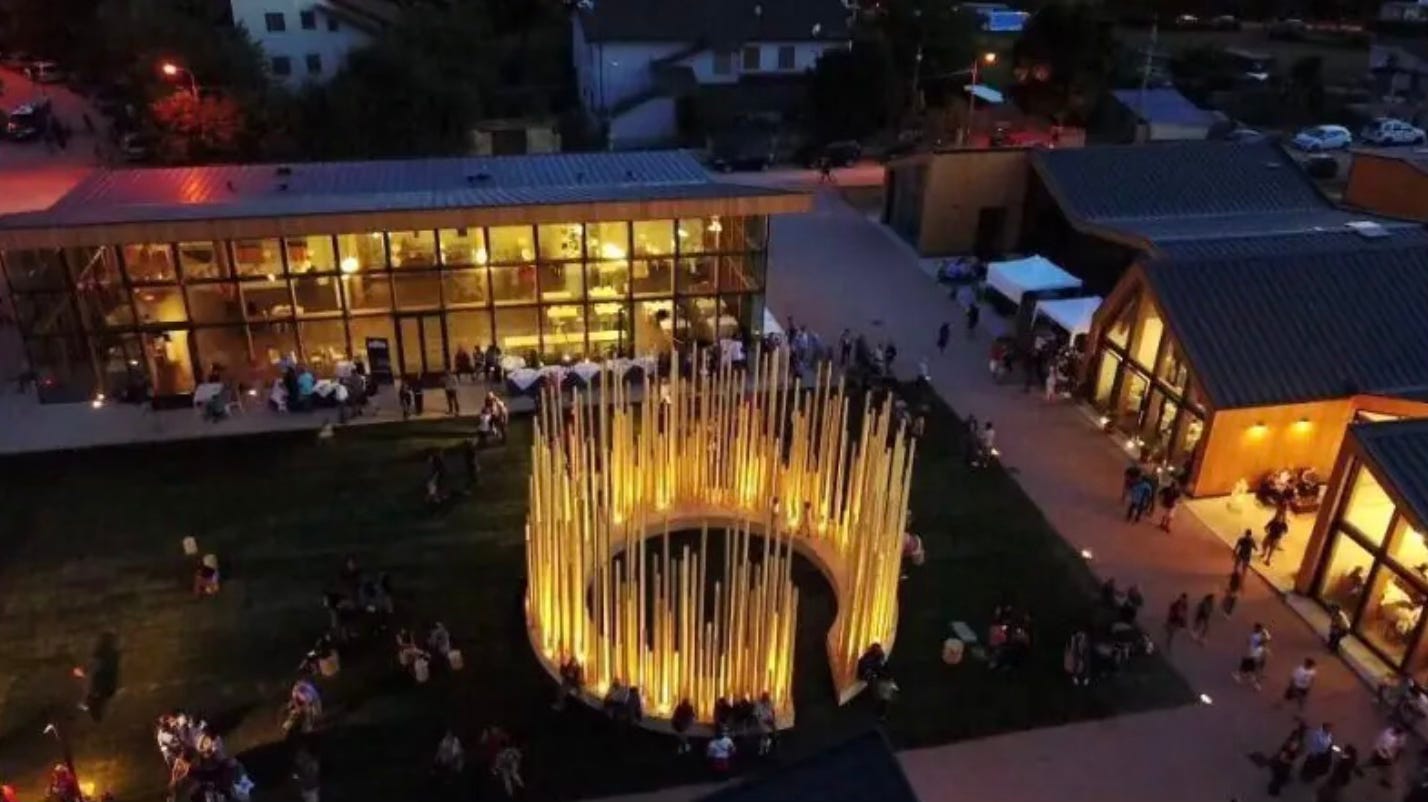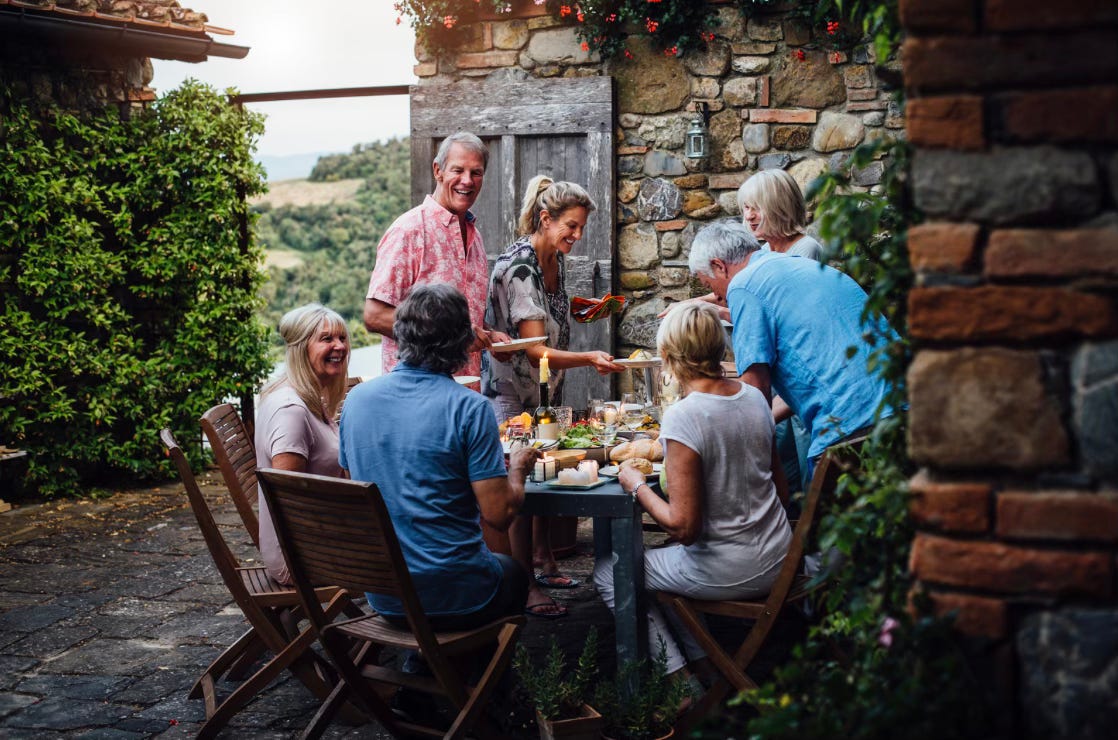Is your obsession with Italy unhealthy?
We say, "No way!" Plenty of people share your passion. Plus, building connections, an agricultural resurgence and the importance of Italian driving schools.
Comfort in Numbers 👥🇮🇹👥💕👥
When was the last time you encountered someone who shared your deep appreciation for everything Italian? If you're anything like me, the moment you discovered this shared passion, there was an immediate sense of comfort, knowing you had found a kindred spirit.
Whether reminiscing about Tuscany's sun-kissed landscapes, struggling with the Italian language, or pursuing that dreamy property along the Adriatic coast, knowing that fellow Italophiles experience similar emotions creates a profound connection.
Here at Italy Per Te, face-to-face meetings may be elusive, but there's an undeniable sense of community in the shared snippets of stories, the exchanged comments, and the collective passion for all things Italy. It goes beyond a mere newsletter; it's a convergence of like-minded individuals on separate paths, yet bound by a love for Italy.
Here's to finding comfort in numbers, in shared joys, and in the knowledge that, even from a distance, we form a community shaped by a common love. Thanks for being here and cheers to our collective journey! 🇮🇹💚
🇮🇹 Building Connections in Italy: Unveiling the Art of Friendship 🤝
As you embark on your Italian adventure, building connections and making friends becomes an integral part of your journey. Recently our A New Life in Italy private community had the opportunity to hear from travel expert Sierra Busch from Creative Edge Travel. She shared some amazing tips to help us establish relationships in Italy, whether during our travels or while integrating into a new hometown. Here’s a snapshot of her advice:
1. Say “Buongiorno!” 🌞
It all begins with a simple "Buongiorno!" Greet the world with an open heart and a friendly salutation. Italians appreciate the warmth of a good greeting, and it sets the tone for positive interactions.
2. Remember: Connection is an Exchange 💫
Sierra reminds us that building connections is a two-way street. Share your experiences, but also listen and learn from others. It's an exchange of stories, cultures, and laughter that creates lasting bonds.
3. Ask Questions, Be Curious 🤔
Curiosity sparks connection. Ask questions about local customs, favorite hangout spots, or even the best gelato in town. Italians love sharing their culture, and your genuine interest will be warmly received.
4. Embrace Standing Out 🌟
Feeling a bit conspicuous? Sierra suggests embracing it! Italians are often just as curious about you as you are about them. Let your uniqueness shine — it's a fantastic conversation starter.
5. Eye Contact and a Smile Matter 😊
Non-verbal cues play a significant role in Italian social interactions. Maintain eye contact and wear that infectious smile. It's a universal language that transcends words.
Whether you're sipping espresso at a local café or exploring the enchanting streets of Italy, remember that building connections is an art. Follow these tips, embrace the warmth of the Italian spirit, and let the journey unfold. 🇮🇹👫✨
What other advice do you have for making friends in Italy? Share it in the comments.
Returning to the Soil - Italy’s Agricultural Resurgence
An interesting movement is quietly brewing among Italy’s fertile fields and bountiful valleys. It’s a resurgence of sorts. Young entrepreneurs throughout the country are returning to one of Italy’s oldest professions, farming, seeking a sense of purpose and joy in cultivating the land. A recent article in The Guardian explores this phenomenon and highlights sustainable practices as well as a cultural connection to the land.
Farming was once the backbone of Italy’s economy but as technology and development boomed, agriculture faded a bit into the background, at least as a career choice. Over the last few decades, many young people have felt obligated to leave the smaller towns in the countryside to pursue more profitable jobs in the bigger cities where more cosmopolitan industries were based. Today, those industries are losing their luster, at least if you look at the statistics.
“Over the past decade, businesses led by people under 35 have declined significantly in many sectors – ranging from a 24% decrease in construction to 25% in retail trade, 28% in textiles, and 48% in telecommunications,” writes Silvia Martelli, author of The Guardian article.
Farming, on the other hand, is growing. It’s a fascinating shift that is not just about the crops.
The green and sustainable movement is having its moment, and agricultural innovators have a powerful platform to champion eco-friendly practices.
The slow food movement, born in the heart of Italy, is also playing a significant role, fostering an appreciation for the craftsmanship behind culinary masterpieces and artisanal products.
Also, the popularity of agritourism turns farms into immersive experiences for visitors, proving that there's both joy and profit in the fields.
Beyond the economic prospects, there's a deeper connection at play — reconnecting with agricultural roots. It's a journey back to the basics, embracing the land, and sowing the seeds for a sustainable and fulfilling future. If this trend continues, perhaps opportunities will be found not just in Italy’s big cities but in small villages and towns throughout the country.
🚗 The Italian Driver’s License: “Do I really need a driving school in Italy?” 🇮🇹
Navigating the Italian roads can be an adventure, especially when it comes to getting your hands on that coveted Italian driver’s license. The burning question often arises: "Do I really need a driving school in Italy?" Well, let's take a ride through the details!
First off, buckle up for a linguistic challenge — the Italian driving theory exam is exclusively given in Italian🇮🇹, although if you're a resident innthr North, some offices offer the exam in 🇫🇷French and 🇩🇪German. For those ready to rev up their language skills, here are some top tips for mastering the Italian driving license journey:
1. 🚦 Join a Driving School (Scuola Guida):
Enrolling in a scuola guida is like having a co-pilot on your language and driving adventure. Many driving schools offer assistance with both theoretical and practical exams. The bonus? Some schools provide English driver’s manuals to make the journey a bit smoother.
2. 📚 Quiz Yourself Online or with Apps:
Get those mental gears turning by quizzing yourself online or through apps. Platforms like patentati.it and Quiz Patente are popular choices. They offer practice tests to help you navigate the nuances of Italian road rules.
3. 🗓️ Plan Ahead and Give Yourself Time:
As they say, Rome wasn't built in a day, and neither is the perfect Italian driver. Plan your study sessions, and give yourself enough time to absorb the rules of the road. While retakes are possible, it's always best to plan accordingly and make the most of the free resources available.
Back to the original question: Do you need a driving school? The answer is, most likely, yes. This process isn’t for the faint of heart so finding support is the best way to ensure success. The exception would be if you are absolutely confident with your Italian fluency (but keep in mind, even native Italians have trouble with this test).
🎁 If you already hold a license from the UK, what a gift! Check out this video about the direct exchange agreement between Italy and the UK:
Now, we want to hear from you! 🗣️ Are you gearing up for the Italian driving exam? Share your thoughts and experiences, or if you happen to possess an exchangeable EU license, let us know in the comments below.
“But nobody around me speaks Italian! How am I going to practice?” 🗣️🇮🇹
There are some countries where learning the local language isn’t absolutely necessary. Italy isn’t one of them. While you can probably get by in the larger cities where tourism is a huge part of the economy, visiting or living in the smaller towns will be much more enjoyable if you have at least a basic understanding of Italian. On top of that, if you plan on working in Italy, a firm grasp of the language is essential.
Beyond the logistical benefits of knowing some Italian, putting in the effort shows respect for the culture, which will help you establish relationships (you can’t truly appreciate Italy without building relationships!). Learning a new language could be the biggest challenge you face when creating a new life in Italy, but it can be done!
Without a doubt, the hardest part of language learning is speaking. Fortunately, there is a surefire way to ensure you master this skill: practice speaking. You can’t improve if you don’t practice, but sometimes finding someone who speaks Italian (at a pace and level that you can understand) can be like searching for a needle in a linguistic haystack. Here are some suggestions to help you connect with language partners:
1. Tandem
Tandem is the ultimate language exchange app, connecting language learners from around the globe. Simply create a profile, specify your proficiency level in Italian, and start swiping through potential language partners. You can chat, voice call, or even video call your way to fluency. With a plethora of enthusiastic learners and native Italian speakers, Tandem makes finding your ideal language partner a breeze.
2. HelloTalk
HelloTalk is another fantastic app designed for language exchange. Think of it as a social network for language learners. Join the Italian community, post text or voice messages, and receive feedback from native speakers. You can even correct each other's sentences, making the learning process both interactive and dynamic. HelloTalk is a vibrant platform that not only helps you practice Italian but also lets you make friends from all corners of the world.
3. iTalki
This online platform connects you with professional Italian tutors and language exchange partners. Whether you prefer structured lessons or casual conversations, iTalki has a diverse range of options to suit your learning style. Engage in live conversations, receive instant feedback, and boost your confidence in speaking Italian with the help of iTalki's supportive community. TIP ➡️ iTalki offers 1-on-1 lessons and group lessons. I just hopped in my group lesson this week (see my note in the intro) and it was great! If you don’t like the pressure of 1-on-1 or need to ease into a program, check out this option.
Remember, speaking is the gateway to fluency, and these resources will have you chatting away in Italian in no time. Embrace the journey, be open to making mistakes, and enjoy connecting with others on this linguistic adventure. Happy language learning!
What’s your key to speaking Italian as you learn the language? Share it in the comments.
Location Spotlight: Amatrice, Lazio 🍝🍷
This week, let’s zoom in on the picturesque town of Amatrice, nestled in the heart of the Lazio region. Known for its rich history and delectable cuisine, Amatrice is poised to be a bit of a phoenix rising from the ashes.
If you google this town, you’ll see that it has had a difficult past. After a devastating earthquake in 2016, rebuilding has been slow for a variety of reasons, but the people are determined to restore Amatrice’s glory. Many people who plan to move to Italy from elsewhere in the world say that they truly want to be a part of Italian culture. Amatrice presents a rare opportunity to do so. This quaint, ancient town could benefit greatly from additional tourists and residents interested in contributing to its rebirth.

The earthquake destroyed the historic center, along with many famed restaurants — the heartbeat of the community. Soon after the quake, a square on the edge of town was built with publically-raised relief funds to house many of these restaurants. Piazza del Gusto, Tradizione e Solidarietà (Taste, Tradition, and Solidarity) serves as a tangible reminder of resilience and determination. Today, fellow Italians and tourists from all over the world line up to dine here — a gesture that goes beyond food.
The natural beauty of this area, as well as the warmth and tenacity of the matriciani are just two reasons to consider visiting or living in this town.
TIP ➡️ Don’t miss the Sagra degli Spaghetti all’Amatriciana at the end of August, a huge, multi-day celebration of the town’s namesake pasta. This irresistible dish is made with bucatini pasta, guanciale (cured pig cheek), pecorino cheese, and tomatoes. Grab a plate (or two) and enjoy live music, performances, and dancing. It’s a classic Italian festa.
Check out this brand new apartment in the heart of Amatrice ⬇️ featured in this week’s Vendita, our weekly property newsletter. The asking price of this modern 2 bedroom (with a large patio!) is €133.000. To receive our list of curated properties every Sunday, Be sure to subscribe via email, or join our Telegram channel. It’s completely free!
ASA (Ask Samantha Anything)
Email us at sophia@smartmoveitaly.com to submit your questions.
Dear Samantha: We are busy narrowing down locations for our property search. So far, we haven’t considered the islands but would love your opinion on doing so. Is there a reason we shouldn’t look at Sicily or Sardegna? Aside from getting there, are there particular difficulties associated with buying/living in either place?
Dear Marlo: Ok Marlo, you've made my heart ❤️ beat a little faster with your question. I'm from the west coast and grew up next to the sea, so the islands have a special place in my heart. Both Sicily and Sardegna are autonomous regions, meaning that they follow Italian law, but have special rights to make decisions over their governing. It also is what keeps their culture very distinctive to the rest of Italy.
These islands are similar, but different. Sicily is huge, in fact it's the largest island in the Med which means there is also a lot of variety to choose from. There are large and chaotic cities like Palermo or Catania and small charming villages like Taormina or Erice. Although many Italians left Sicily in the early 1900's, many of their ancestors are returning seeking a slower, more simple lifestyle. Sicily is beautiful, unique, and steeped in history. You will also get a lot more for your money, so if you're on a budget, this is a good option. But it is not an easy place to live. Services are not as advanced, modern infrastructure is lacking and there are many areas that are quite poor. On the other hand, food, sun, beaches, and of course the Sicilian people can make up for the bumpy roads and inconveniences.
Sardegna, I often say is like Hawaii, 50 years ago, and I believe there are few places left on this earth like it. Although rugged in the centre of the island, you can find modern living and services along the edges. The Costa Smerelda is considered one of the most elite places on the planet, and it only takes one visit to see why. Sardegna also has some of the most beautiful white sand beaches in the world. They are truly breathtaking. The roads and infrastructure are quite good (surprisingly) and you can tell it is poised for development. I love Sardegna, so much so we have a summer beach house there and I could easily see living there full-time in the future.
Like Sicily, the inland areas are very rustic but you can get a lot for your money. However living in these areas can feel quite remote and isolated. I prefer the coastal towns and villages. It is more expensive but the lifestyle and services are better.
Living on either island is different from mainland in almost every way. The pace is slower, services reduced, and it's less convenient. Having a strong attraction to the sea is usually what draws people in and steals their hearts. If this is what you're looking for in your new life in Italy, I say go for it!
Your Ideal Italian Vibe 🏞️
Before we say arrivederci, I’d love for you to share your thoughts on your ideal Italian vibe. If you had the choice, what would your new life in Italy look like?
If you have something else in mind, let me know in the comments.
We know your inbox is a special place so thank you for being a subscriber and a part of the Italy Per Te famiglia. As always, the door is always open if you’d like to share your thoughts. Until next week, a presto!











